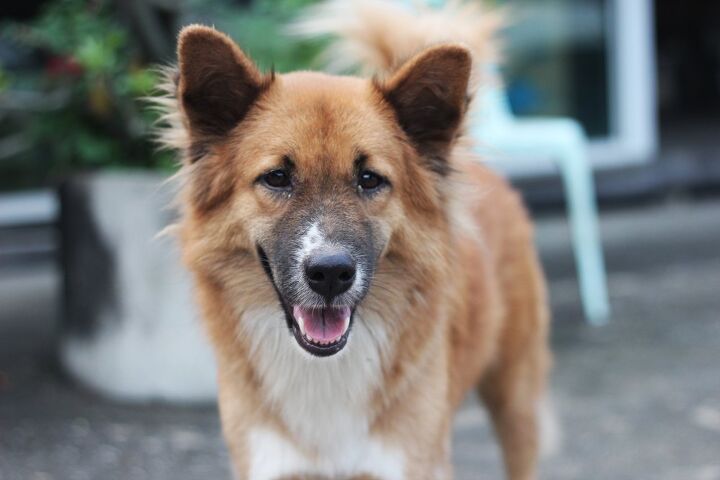Pomeagle


About Pomeagle
Devoted, energetic, and intelligent, the Pomeagle is a great choice for active families or singles. One of the many popular designer dog breeds, the Pomeagle is a cross between two well-known and loved breeds, the petite and feisty Pomeranian and the stubborn but loyal Beagle– hence the name. As they are quite smart and curious and have a high level of energy, these mixed breed canines will need a stimulating environment to thrive; both mentally and physically. This makes them particularly suitable for agility training, as Pomeagles will learn quickly and cherish any fun challenge that they come across.
Usually medium-sized, the energetic and friendly Pomeagle is a great choice for active families or singles.
The term ‘designer dog breed’ is relatively recent, as it was only in the last few decades that people started crossing dogs of different breeds on purpose, in hope to create a new breed that would offer the best of both worlds; meaning less breed-specific health issues, improved personality traits, and even correction of other traits, such as more desirable size or better coat quality. The same applies to the Pomeagle. While it’s certain that there have been numerous Beagle and Pomeranian mixes throughout history, it’s only recently that those crossings have been intentional. There are very few reputable Pomeagle breeders out there, though, as designer dogs are still a phenomenon in the making, but it’s highly likely you’d be able to find an “accidental” Pomeagle for adoption in a local shelter or rescue organization.
Both the Pomeranian and Beagle are breeds in good standing with the American Kennel Club (AKC) and have the right to get a certified pedigree, yet their mixed breed offspring doesn’t enjoy the same privilege. As a designer dog breed, Pomeagle is not recognized by the AKC, and therefore, can’t obtain their official pedigree. The reason for this is that hybrid dog breeds are usually only first generation crosses, so there is no set of standards the puppies must adhere to in order to be considered a certain breed. The lack of uniformity might prevent these crossbreed dogs from having a pedigree, but for most people, their individuality is precisely what they love about Pomeagles.
Feeding your Pomeagle puppy a wholesome, well-balanced diet is an absolute must. However, that doesn’t mean that you’ll have to move heaven and earth to find food specially designed for Pomeagles; any type of high-quality kibble that suits your pet’s size and activity level will do just fine. Depending on which parent’s genes are more dominant, you might have a tiny, 7-pound dog, or a compact, sturdy canine that’s up to 20 lbs heavy. Choose their kibble accordingly- it’s safe to assume dry food for active dogs will be a match in any case, as Pomeagles are very energetic and need a lot of exercise.
Feeding your Pomeagle puppy a wholesome, well-balanced diet is an absolute must- choose a high-quality kibble.
When it comes to Pomeagle and training, it’s all going to depend on your puppy’s individual character. If you’re lucky, your pooch inherited the best of both breeds and is an eager-to-please, intelligent dog that would like nothing more than to learn tricks or commands that would make his owner proud. On the other hand, your new four-legged companion might have gotten the famed stubborn streak of the Beagle, or the feistiness of the Pomeranian, training will require a bit more patience on your side. The good news is that in both cases, this designer dog will have no trouble picking up what you’re telling them b do, as they’re quite smart.
As the Pomeranian and the Beagle, the two breeds that were used to create the Pomeagle, are not too similar sizewise, there are some big variations that could occur, even across one litter, let alone the whole breed. The expected weight of a fully grown, mature Beagle is 18 to 30 pounds, whereas the tiny Pomeranian usually weighs about 3 to 7 pounds, even as an adult. This is also the reason why the mom of Pomeagle puppies is always a Beagle female; a Pomeranian wouldn’t be able to give birth to such large puppies.
If you want a happy-go-lucky puppy, that will grow to be a fiercely loyal, inquisitive, and a smart dog, then you’ll love the Pomeagle. Owing to the unique mix of genes in their ancestry, these mixed breed dogs tend to be a great blend of independent and affectionate, curious and lively. In case that they have been properly socialized on time, Pomeagles will be a devoted pooch that will enjoy kicking it back by your side, but they’ll still be friendly to other people and family members, even the younger ones. However, as a generally small breed, these petite puppers don’t appreciate being manhandled, and can get nippy with kids who pick them up as they please or play rough, so particular attention is required if you have children in the household.
In general, Pomeagles are sweet dogs that do well in most settings. As long as they have a healthy outlet to spend that excess energy, and get their inquisitive, smart minds challenged with games and interactive toys, they’ll be perfectly happy snuggling with you at the end of the day, or taking a nap at your feet while you watch the TV. However, if you fail to meet their needs, they can become depressed and destructive.
One of the Beagle traits that most mixed breed dogs tend to inherit from that side of the family is their curious and powerful nose, which, combined with the Pom’s alertness and tendency to bark at strangers, makes them good watchdogs. Granted, their size prevents them from being actual watchdogs, but this doesn’t mean that your little Pomeagle won’t bark their head off if they sniff out anyone they don’t know lurking about. Too bad it’s usually just the postman.
Ideally, designer dog breeds should be healthier than purebred dogs, as they “dilute” the pureness of the breed by introducing some new genes into the gene pool. In reality, that is not always the case. While some dogs can get lucky on the genetic lottery and inherit only the best traits of both breeds and none of the predispositions for health issues, that rarely happens. The crossbreeding might lower your pet’s chances of being affected by breed-specific health problems, but it doesn’t grant them a full immunity.
Whenever you’re curious about a certain trait of a hybrid dog breed, it’s a safe bet to look at the corresponding traits of the breeds that went into its making and make an educated guess. This is particularly true when it comes to determining the lifespan of a mixed breed pooch- considering that they haven’t been around that long as an official breed, there’s not enough information about their longevity.
This a fairly active dog, and, no matter which parental breed they take up after, Pomeagles will need daily exercise to stay happy and healthy. Otherwise, their powerful sniffer might take them into the direction of trouble! A couple of daily walks, combined with some quality playtime should do the trick for most pooches, even those who are more like their Beagle parent.
As these are fairly active dogs, Pomeagles will need daily exercise to stay happy and healthy.
The AKC doesn’t consider designer dog breeds to be breeds in their own right, but this doesn’t mean that other canine organizations and clubs don’t realize that there’s a growing need for recognition of crossbreeds. The organizations that recognize the Pomeagle include American Canine Hybrid Club, Designer Dogs Kennel Club, Dog Registry of America, and International Designer Canine Registry.
The lack of uniformity might be the only thing that’s guaranteed with designer dog breeds: the way your Pomeagle puppy looks like when fully grown will largely depend on which of the parental breed it takes after. When it comes to their coat, this means that their hair can be either short, straight, and sleek like the Beagle’s, or furry, fluffy and long like the beloved Pomeranians flaunt. Usually, they turn out to have a medium-length coat, of normal density and with moderate shedding tendencies.
As for the colors, Pomeagles can sport a whole palette: from tricolor to mono, and from black to fawn, anything is possible.
The Pomeagle can be strong-willed, energetic, and outgoing as their Beagle parent, or take up after the Pomeranian in the mix, being intelligent, friendly, and loyal. Or it can be the perfect blend of both! Usually medium-sized, these dogs have a fairly high activity level and will do best with a family that can help them spend that excess energy in a constructive way, through quality playtime or dog sports, such as agility.
Photo credit: Kanchana Tuihun/Shutterstock

A proud mama to seven dogs and ten cats, Angela spends her days writing for her fellow pet parents and pampering her furballs, all of whom are rescues. When she's not gushing over her adorable cats or playing with her dogs, she can be found curled up with a good fantasy book.
More by Angela Vuckovic

























